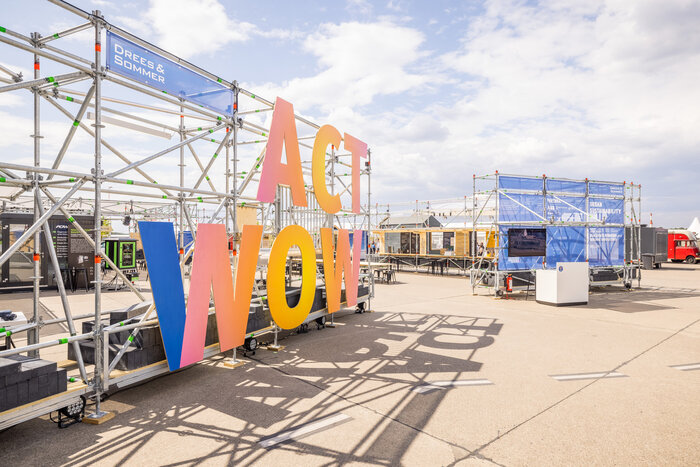Lean management in everday life

For years, industrial companies have successfully worked with lean production. They have optimized the timing of their processes and eliminated all of their superfluous activities. Even in construction projects, lean production can be used in the form of LCM. Why not also use the lean approach to optimize our everyday life!?
The smartphone with the running app is fully charged and in its right place next to the charger. The complete running kit for temperatures of 5 to 10 degrees above freezing point – consisting of a T-shirt, a light running jacket, ¾-length trousers and socks in a single bundle – is ready as always in the drawer marked ‘sports kits’, and it will take just a few seconds to take it and put it on. Clean running shoes are in their appointed place at the bottom left of the shoe cupboard. The door keys are on the key rack above the shoe cupboard. Preparation time before training: 3 minutes 30 seconds. An ideal running pace for efficient training is defined by the running app. Training ends after exactly 45 minutes. Then you hang up the keys. Dust off the shoes and put them into the cupboard. Put the clothes straight into the basket labelled ‘30 degree sportswear’. Put the smartphone in its place. Drink 0.4 liters of water. Shower. Total time for the training session: 58 minutes.
Commendable, but not normal. Most amateur athletes are perhaps more familiar with the following scenario: Look for mobile phone and note that it is not charged. Connect it to the charger. Then go and put on running shorts. Check the temperature and decide to wear something longer. Realize that your favorite T-shirt is still in the laundry. Put on a pullover that is much too warm. Where did you leave the door key? Before you realize it, a quarter of an hour has passed, and you haven't even started your workout yet. Obviously runner 1 is extremely well organized, and runner 2 is chaotic. But what has this got to do with the lean concept?
Avoiding waste
The lean concept is based on the Toyota Production System (TPS) developed in the 1970s by Taiichi Ohno. TPS aims to make production more efficient by eliminating all wasted efforts. Production should not exceed the actual demand, inventory should be reduced, transport distances shortened, complicated processing and superfluous movements limited, waiting times and reworking should be minimized. The basic idea of structuring processes so that they eliminate wasted effort and concentrating instead on the actual added value for the customer has been implemented in many sectors of business and commerce: lean management, lean office – and in the construction industry in the form of: Lean Construction
Tools and more tools
With LCM, Drees & Sommer applies the advantages of the Toyota production system to the construction industry, in other words to construction projects and processes. The lean process means that construction projects can be faster, more reliable, less chaotic – and in the last resort more economical. Just-in-time, the 5S method, KAN-BAN, SCRUM … The lean management system includes numerous tools – but it is not possible or necessary to use them all in the same way in every project. For Drees & Sommer, the important thing is that the standard procedure is used in every project and that its staff understand and implement the underlying approach and philosophy. Lean management also means change management and placing a focus on processes by using standards, visualization, daily verifiability and discipline.
To help achieve this, Drees & Sommer has set up an LCM expert center. In every location, there are staff members who act as LCM advocates and help to set up customer projects correctly using lean methods.
Applying lean in practice
Coming back to the question of whether lean is practical outside the world of work – one important element is the 5S method. If desired, this method can also be applied to everyday life.
Sort:
Sort out old books and magazines, dusty old decorations, clothing, shoes … If we regularly fight against our internal ‘messy’, we can then feel free. If we apply this to the ‘running’ example above, it means that we don’t keep old and worn-out trainers (perhaps with the exception of the shoes we used to run our first marathon or our first continuous 6-mile run). Emotions are sometimes strong. Perhaps we could compromise by taking a photo of our old favorite trainers – and throwing away the shoes themselves.
Set in order:
If everything is in the right place, we don't have to spend time looking. This assumes that we have enough self-discipline to define a proper place for everything and to take it back to this place immediately if it ever moves away. In families with small children it is enough to do this once a day – otherwise we fall foul of the principle of avoiding unnecessary walking and duplicated tasks. But perhaps we could try to put our running kit in piles that are sorted by suitability for different outdoor temperatures.
Shine:
Perhaps it is not an accident that lean rhymes with clean. Regularly keeping everything clean and tidy is perhaps worthwhile not only in the workshop (or on the building site if possible). Experience shows that if we want to clean, we automatically have to tidy up first. And it is only logical that our running T-shirt must go in the washing after we have used it.
Standardize:
The same procedure every time; the same quality standards. This principle increases efficiency and speed in production and construction processes, and it may also be a way to improve our everyday routine. Change clothes first, take the smartphone, put the trainers on and then get the door key. Runner 1 always prepares his training sessions in the same way and gets out of the door quickly – he no longer has to think about the process and does not lose any unnecessary time. And on the run he is careful to use an efficient running style, for example without any superfluous up and down movements.
Sustain with Self-Discipline and Constant Improvement:
Implementing and maintaining a lean process is easier for some people than for others. Lean also means questioning firm habits. Is the way I travel to work really the fastest, best and safest route? What could I improve? Runner 1 could perhaps save twenty more seconds if he used a fast lacing system for his trainers.
Banishing Lean from the Weekend and from Vacations
Conclusion: the lean method may be helpful for people who get annoyed at their own inefficient and chaotic everyday habits. If we internalize the lean process, this could help us to avoid overloading our cupboard with groceries, and we would not run out of milk. But it would be overdoing it if we divided our weekend up into strict time windows for every single activity.
And it sounds strange to use the words ‘vacation’ and ‘efficiency’ in the same sentence. Sometimes it is best just to let things drift by, to spend 48 hours or even a few weeks without thinking of productivity and efficiency, to celebrate inefficiency, to waste time deliberately and with a good conscience, or simply to enjoy not having to think about and optimize every single thing. Successful lean management can bring great satisfaction in the office, on the building site or at the production line, but doing sweet nothing can sometimes also be very satisfying.
![[Translate to English:] Sergey Nivens - Fotolia.com](https://cdn.dreso.com/fileadmin/_processed_/7/5/csm_Warum_findet_der_Earth_Overshoot_Day_immer_frueher_statt_acd6ee15f9.jpg)

